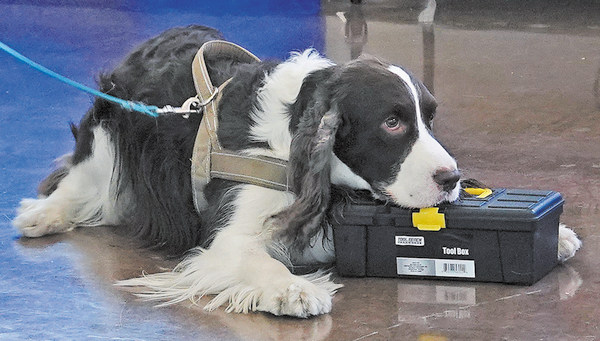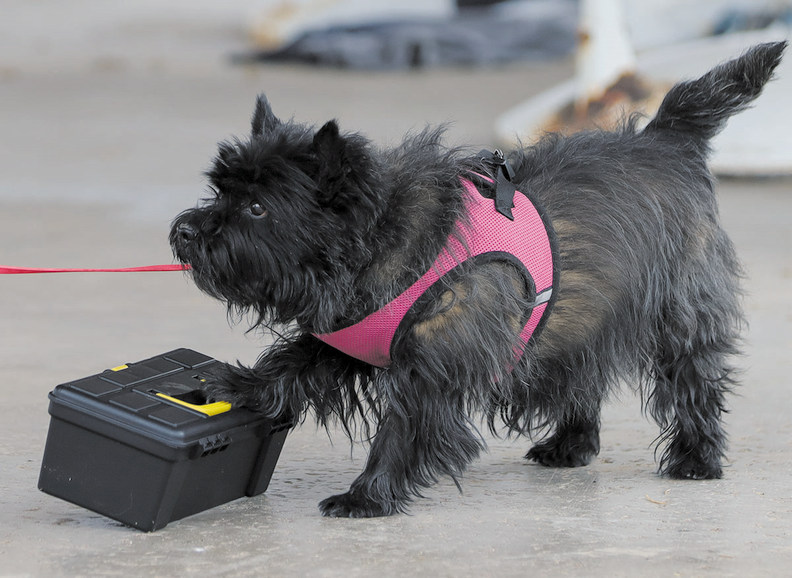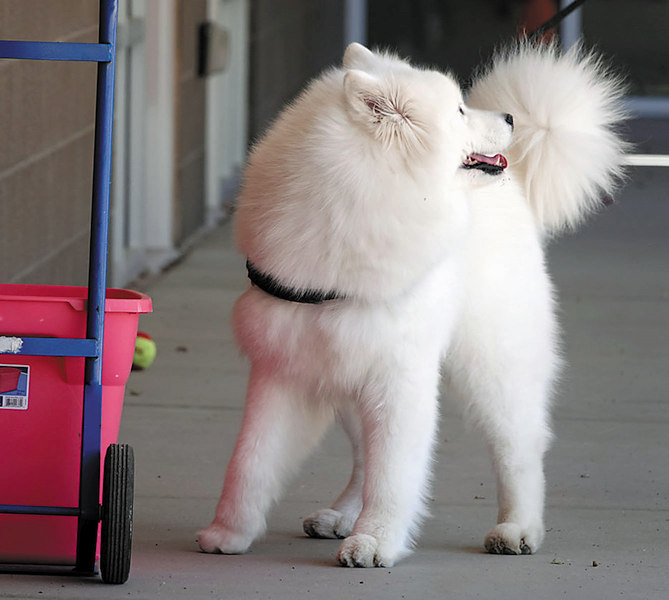By Heidi Dahms Foster

Dogs’ noses are 10,000 to 100,000 times more sensitive than human noses. Most people are familiar with police K9s that can sniff out even the most carefully hidden drugs, or track a stealthy criminal or a lost person. Now, canine scent work has become an extremely popular sport with dog owners who enjoy working and competing with their canine companions.
In scent work, dogs search for cotton swabs saturated with the essential oils of Birch, Anise, Clove, and Cypress. The cotton swabs are hidden out of sight in a pre-determined search area, and the dog has to find them. Handler and dog must work together—when the dog finds the scent, he has to communicate the find to the handler, who calls it out to the judge.
The sport of scent work gives your dog carte blanche to sniff to its heart’s content, and turns this essential dog trait into a fun game for handler and canine alike. In many dog sports the handler is in control, but that’s not true in scent work. This is a challenge to a lot of handlers as they must learn to trust their dog and allow it to work, rather than directing every move. In a scent work trial, neither the dog nor handler knows where the target odor is hidden. The handler must learn to follow the dog and read its signals, which could be something as subtle as a change in behavior, a tail or ear change, or a more obvious alert such as a sit or down. Then the handler must remember to indicate to the judge that their dog has found the scent.
The American Kennel Club website outlines their scent work trials or competitions, which are divided into different categories, known in the sport as elements. Each element involves a dog conducting a different type of search or searching a different environment. There are four different scent work elements in AKC competitions: container, interior, exterior, and buried.
- Container: an odor is hidden inside of a container, such as a cardboard box or briefcase. Dogs are faced with a variety of boxes and must alert their handler to which box the scent is hidden within.
- Interior: an odor is hidden in an inside search location. However, unlike with the container element, the odor can be hidden anywhere within a defined indoor area.
- Exterior: an odor is hidden on or in an object within a defined outdoor area. These searches can be more complicated for dogs because they must consider factors such as changing airflow and weather conditions, as well other changing natural or environmental distractions.
- Buried: an odor is hidden within a container, which is then buried in sand or water. The dog must sniff out the presence of the hidden scent, and alert their handler to which container it’s buried in.
Each element has four different classes, or levels of difficulty. These are Novice, Advanced, Excellent and Master. For each element, dogs start competing at the Novice level, then work their way up.
In AKC scent work, birch oil is used for the Novice level: birch and anise oils for the advanced level; birch, anise and clove for the Excellent level; and birch, anise, clove, and/or cypress for the Master level. Other registries have similar containers and scents, with variations.

An online search will reveal several other registries that exist for training and putting on scent work events, including the National Association of Canine Scent Work (NACSW), United States Canine Scent Sports (USCSS), and more. Additionally, many single breed registries such as the Australian Shepherd Club of America have scent work programs in which dogs of all breeds and mixed breeds can compete. Locally, the Chino Valley Canine Training Club hosts scent work trials and seminars on a regular basis.
Maggi Lieber has competed in scent work with her Cairn Terriers, successfully reaching the advanced levels in the sport. Her Cairn, Mazie, competes in both AKC Scent Work where she is close to completing her Overall Master Elite Title, and in NACSW where she has her Element Title in Vehicle, Interior, Exterior and Containers and one leg towards her NW3 Title. Her Cairn Dottie also competes in both venues, currently working towards her Excellent Elite Titles and her NW2. The NW numbers indicate the level of scent work the dog has achieved.
“Scent work is a wonderful way for a withdrawn or shy dog to gain confidence as it is one of the few sports where the dog is basically in charge and they are using their biggest asset, their nose,” she said. “I started my Cairn Terrier Dottie in scent work to help her gain ring confidence as she lacked animation in conformation. After doing scent work, she gained that attitude and finished her championship.”
Scent work is one of the few sports that forces a handler to closely read the dog, spotting subtle clues for when the dog is “in odor” or has found the scent. It helps handlers better understand their dog. “As for myself,” Lieber said, “It helps to grow that handler/dog bond because it is a team sport.”
Scent work is easy to begin, and one of the best ways is to find a class or trial where you can familiarize yourself with the basics. “For beginners,” Lieber said, “I cannot think of a better way to get involved in this sport then going to a trial, or two or three, to watch and/or volunteer to help. Most elements you can watch and clubs are always on the hunt for volunteers. Without volunteers these events just wouldn’t happen.”
Bambi Ellis, another CVCTC member who competes in scent work with her Australian Shepherd Hemi, got started in the sport after trying herding and finding it was not a fit for them. “If you know Australian Shepherds, you know they need jobs. It’s nice to be a team with the dog. Hemi is pretty good at scent work,” she said. “I’m fortunate that she picked her own alert posture and it’s a down – it’s obvious when she thinks she has found the scent.”

Darla Cassidy currently competes in scent work with her Samoyed Halo. She previously competed with two other Samoyeds who are now retired. She likes what working with her dogs in performance sports for the bond it creates between handler and dog, and the physical health and mental benefits it provides.
“Anytime you’re working with your dog in performance sports it is going to create a tight bond, not only from time in the trials but from all the practice and camaraderie it creates with other people and their dogs. These events keep my dogs active, which keeps them in good health in regards to weight management and structural soundness. The dog not only has to use its nose in scent work but they have to “think” which helps to keep their cognitive process working on daily basis.”
No matter how far handler and dog go in scent work, seeing your dog thrive at something they are built to do is gratifying.
“Scent work is a thinking sport for dogs. It’s a mental game for them. I have no idea how they do it, how they pick a scent that’s hanging in a tube on a bush that doesn’t belong there. It amazes me—dogs are so smart,” Bambi Ellis said.
Scent Work Resources
- Chino Valley Canine Training Club: cvctc.net
- Release Canine https: releasecanine.com
- American Kennel Club: tinyurl.com/j6u2ja32

